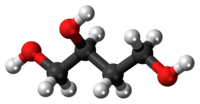1,2,4-Butanetriol
 | |
 | |
| Names | |
|---|---|
| IUPAC name
Butane-1,2,4-triol | |
| Other names
1,2,4-Butanetriol 1,2,4-Trihydroxybutane Triol 124 2-Deoxyerthritol | |
| Identifiers | |
| 3068-00-6 | |
| 3D model (Jmol) | Interactive image Interactive image |
| ChemSpider | 17287 |
| ECHA InfoCard | 100.019.385 |
| EC Number | 221-323-5 |
| RTECS number | EK7176000 |
| |
| |
| Properties | |
| C4H10O3 | |
| Molar mass | 106.12 g·mol−1 |
| Density | 1.19 |
| Boiling point | 190 to 191 °C (374 to 376 °F; 463 to 464 K) 18 torr |
| Hazards | |
| R-phrases | R36 |
| S-phrases | S24/25 |
| NFPA 704 | |
| Flash point | 112 °C (234 °F; 385 K) |
| Except where otherwise noted, data are given for materials in their standard state (at 25 °C [77 °F], 100 kPa). | |
| | |
| Infobox references | |
1,2,4-Butanetriol is a clear or slightly yellow, odorless, hygroscopic, flammable, viscous liquid. It is an alcohol with three hydrophilic alcoholic hydroxyl groups. It is similar to glycerol and erythritol. It is chiral, with two possible enantiomers.
1,2,4-Butanetriol is used in the manufacture of butanetriol trinitrate (BTTN), an important military propellant.
1,2,4-Butanetriol is also used as a precursor for two cholesterol-lowering drugs, Crestor and Zetia, which are derived from D-3,4-dihydroxybutanoic acid, by using 3-hydroxy-gamma-butyrolactone as a chiral synthon Niu, W (2003). "Microbial synthesis of the energetic material precursor 1,2,4-butanetriol". Am. Chem. Soc. 125 (43): 12998–12999. doi:10.1021/ja036391+. "Biosynthetic Pathways". Retrieved 24 November 2010.. It is as one of the monomers for manufacture of some polyesters and as a solvent.
1,2,4-Butanetriol can be prepared synthetically by several different methods such as hydroformylation of glycidol and subsequent reduction of the product, sodium borohydride reduction of esterified malic acid, or catalytic hydrogenation of malic acid.[1] However, of an increasing importance is the biotechnological synthesis using genetically engineered Escherichia coli and Pseudomonas fragi bacteria.[2]
References
- ↑ Chemical & Engineering News, May 31, 2004, Volume 82, Number 22, pp. 31-34, "Biomass or Bust" Web version
- ↑ The State News, Feb. 12, 2004, "Propelling Research" by Meghan Gilbert. = 22196 Web version
